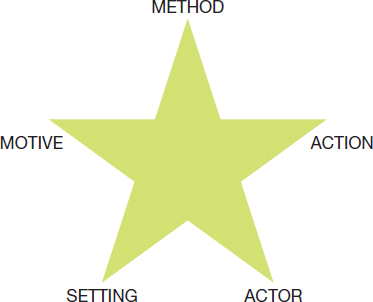Use the five elements of dramatizing.
Dramatizing is an invention activity developed by the philosopher Kenneth Burke as a way of thinking about how people interact and as a way of analyzing stories and films.
Thinking about human behavior in dramatic terms can be very productive for writers. Drama has action, actors, setting, motives, and methods. Since stars and acting go together, you can use a five-pointed star to remember these five points of dramatizing: Each point on the star provides a different perspective on human behavior (see Figure 11.2).

Action An action is anything that happens, has happened, will happen, or could happen. Action includes events that are physical (running a marathon), mental (thinking about a book you have read), and emotional (falling in love).
Actor The actor is involved in the action—either responsible for it or simply affected by it. (The actor does not have to be a person. It can be a force, something that causes an action. For example, if the action is a rise in the price of gasoline, the actor could be increased demand or short supply.) Dramatizing may also include a number of coactors working together or at odds.
Setting The setting is the situation or background of the action. We usually think of setting as the place and time of an event, but it may also be the historical background of an event or the childhood of a person.
Motive The motive is the purpose or reason for an action—the actor’s intention. Actions may have multiple, even conflicting, motives.
Method The method explains how an action occurs, including the techniques an actor uses. It refers to whatever makes things happen.
Each of these points suggests a simple invention question:
- Action: What?
- Actor: Who?
- Setting: When and where?
- Motive: Why?
- Method: How?
This list looks like the questions reporters typically ask. But dramatizing goes further: It enables us to consider relations between and among these five elements. We can think about actors’ motives, the effect of the setting on the actors, the relations between actors, and so on.
You can use this invention strategy to learn more about yourself or about other significant people in your life. You can use it as well to explore, interpret, or evaluate characters in stories or movies. Moreover, dramatizing is especially useful in understanding the readers you want to inform or convince.
To use dramatizing, imagine the person you want to understand better in a particular situation. Holding this image in mind, write answers to any questions in the following list that apply. You may draw a blank on some questions, have little to say to some, and find a lot to say to others. Be exploratory and playful with the questions. Write responses quickly, relying on words and phrases, even drawings.
- What is the actor doing?
- How did the actor come to be involved in this situation?
- Why does the actor do what he or she does?
- What else might the actor do?
- What is the actor trying to accomplish?
- How do other actors influence—help or hinder—the main actor?
- What do the actor’s actions reveal about him or her?
- What does the actor’s language reveal about him or her?
- How does the event’s setting influence the actor’s actions?
- How does the time of the event influence what the actor does?
- Where does the actor come from?
- How is the actor different now from what he or she used to be?
- What might the actor become?
- How is the actor like or unlike the other actors?